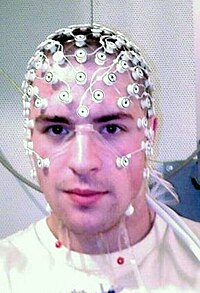
Photo from wikipedia
Introduction: The present study investigated how new words with acquired connotations of disgust and sadness, both negatively valenced but distinctive emotions, modulate the brain dynamics in the context of emotional… Click to show full abstract
Introduction: The present study investigated how new words with acquired connotations of disgust and sadness, both negatively valenced but distinctive emotions, modulate the brain dynamics in the context of emotional sentences. Methods: Participants completed a learning session in which pseudowords were repeatedly paired with faces expressing disgust and sadness. An event-related potential (ERP) session followed the next day, in which participants received the learned pseudowords (herein, new words) combined with sentences and were asked to make emotional congruency judgment. Results: Sad new words elicited larger negative waveform than disgusting new words in the 146–228 ms time window, and emotionally congruent trials showed larger positive waveform than emotionally incongruent trials in the 304–462 ms time window. Moreover, the source localization in the latter suggested that congruent trials elicited larger current densities than incongruent trials in a number of emotion-related brain structures (e.g., the orbitofrontal cortex and cingulate gyrus) and language-related brain structures (e.g., the temporal lobe and the lingual gyrus). Discussion: These results suggested that faces are an effective source for the acquisition of words’ emotional connotations, and such acquired connotations can generate semantic and emotional congruency effects in sentential contexts.
Journal Title: Frontiers in Psychology
Year Published: 2023
Link to full text (if available)
Share on Social Media: Sign Up to like & get
recommendations!